

| Home | Cut Gemstones | Rough | Articles | Links | Contact | Gem Weight Estimator |
The Great Andesine ScamWritten by Gary KratochvilAll photos by Gary Kratochvil except as noted Copyright 2008 First published May 17, 2008 Updated on June 8, 2008
|
| First I will say that I think the vast majority of red andesine (or andesine-labradorite) on the market today has been treated. The complete story of what I call The Great Andesine Scam has not been completely revealed as of the time of this publishing, however, I will discuss and disclose the information I have at this time. This article discusses red andesine as that is the color for which I have the most photographic evidence. Please note that the green andesine and bicolor andesine all fall into the same treatment methods. As I gather more photos I will update this page. As more information is uncovered the updates to the story will be posted on this page and a notation at the top of the page as to the date of the last update. Currently there are many people working on this issue. No person or lab has all the answers at this time. The end of this scam will be a death by a thousand cuts. |
| Since 2002 when andesine started to hit the market I have heard and seen many things that just don't add up. I suspected that there was some sort of treatment involved. My comments are based on my experiences since 1972 in buying, selling and faceting gem material. I don't have a "Dr." in front of my name or a "Ph.D." behind it, but what I do have is real life gem dealing experience and an appropriate amount of common sense. I also have a "box of experience". What is a box of experience? That's where you keep all the stuff you bought that wasn't what it was supposed to be or paid way too much for. That box will teach you more than any degree will if you are smart enough to figure out what you did wrong. Fortunately I haven't added to that box in many decades. |
| It should be noted that I don't have a problem with gemstone treatments. It wouldn't matter if I did. The treatment of gemstones has been around for a long time and will continue forever. What I do have a big problem with is the treatments that are not disclosed to the consumer. This is nothing but fraud and the perpetrators should be prosecuted as the criminals they are. I've heard stories of people "investing" in this material for the security of their future. This is what I have a real problem with. I don't want to see innocent individuals being ripped off by a slick talking television host or deceitful sales person. This is my motive for waving a big red flag about andesine. |
| Recently I've posted my concerns on an online gemological forum and was accused of having an "agenda to sell stones I am mining" by the owner of the forum. I do own many BLM mining claims in Oregon. I could care less if anyone reading this ever bought a single stone from me. That is not my motive. I have more customers for top red natural labradorite than I have material to sell them. It seems there are a lot of people who have bought into this scam hook line and sinker. These same people would rather blame the messenger than admit they might be wrong. To everyone that believes that andesine is not treated buy it now as the price is down. Take a second mortgage out on your house and buy, buy, buy! Don't worry, if they run out they will make more. In the future most all the andesine you buy now will be in your "box of experience" and you will be a vocal advocate when the next scam hits the market. To anyone with an open mind please be very wary of any andesine you buy. Again I think most of it is treated. I have been amazed at all the people with "GG" behind their name have not been at least telling buyers to be cautious! Many so called "gemologist" are content to wait for more reports before they even express concern or have the capacity to form their own opinion and express it. This armchair gemology has no place in the real world where well intentioned people spend their hard earned money every day on stones that may be treated. |
| So what hasn't added up? First of all as a faceter I know there is obviously rough for every type of cut stone. Since 2002 many cutters I know have been looking for ANY rough andesine. There has been absolutely none! This fact stinks all by itself. There is always something available. With andesine there wasn't even any cobbing scraps. Any cutting house would gladly take money for any of the leftover material they have. There is always some material that comes in a parcel that cannot be cut. The cutting houses pay for everything they have, even what cannot be faceted or cabbed. Why has there been nothing to buy? Because they don't want you to see what the rough really looks like. If anyone with experience in rough sees the material they are cutting they would know immediately that the material is treated. There are not even any mineral samples for sale! Can you name another stone where the same situation exists? |
| Other stories have emerged over the past years that are equally unbelievable. One of the sellers of andesine was asked where their mine was. Their answer was that it was in Tibet at an elevation of 19,000 feet. The elevation was part of the story as to why the material was so rare! Then the seller produced a picture of the "mine" taken from a distance. The picture had trees in it. What? Trees at 19,000 feet! They could not even research their lie to realize that trees don't grow at that altitude. Then there are the stories of how the area where the mine is located is war torn and too dangerous to visit. How convenient. What about the fact that no western geologist has been taken to Congo, Tibet, China, Mongolia or whatever the location of the month is to verify its existence and verify the mine produces natural red labradorite? At this time the only proven deposits of natural red labradorite are in Oregon. Then there is the story that we have mined out the entire deposit and there is nothing left to see. Again, how convenient. |
| There is a seller of red andesine that is always saying "I have certificates!". Yes I guess they do have certificates that say what they are selling is andesine. But wait! What the certificates don't say is if the red color is natural. Be careful not to read more into a "certificate" than it actually says. As this story unfolds I think there may be some labs that would like to have some of the paperwork they have issued back. |
|
I have worked with colored stones for a long time. It is very unusual to see vast quantities of one type of colored stone
that all match exactly in color and tone. When I see tables full of cut stones that all match I am very suspicious. I took the pictures below at the
2008 Tucson Gem Show. The sellers of this material say it is all natural and from a mine in China. I inquired about buying rough but of course there was
none for sale. Another dealer friend of mine told me this same company bought 30,000 kilos of yellow labradorite from a mine in Mexico. This particular
mine only produces yellow labradorite but yet the company in Tucson had no yellow for sale.
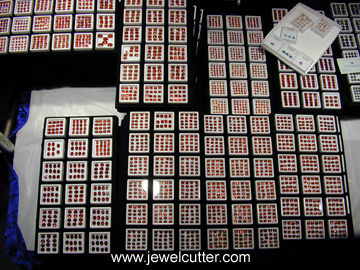
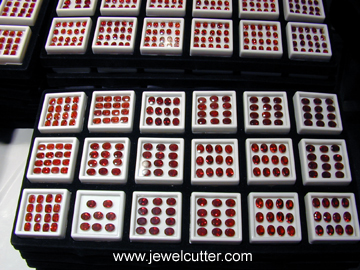
|
|
The issue of no rough available has been discussed for the last few years. One dealer in the 2008 Tucson Gem Show apparently
thought he could use that to his advantage. He brought what he called rough to the show to somehow prove that his cut stones were natural. The material
he was showing as rough might have fooled somebody who has never seen a single piece of rough material of any kind. This dealer was of course saying it
was all natural and untreated. I managed to take a few pictures posted below. I will go into more detail as to why I think the rough is treated later in
this article.
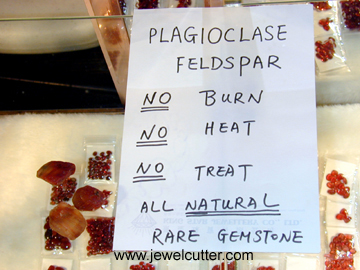
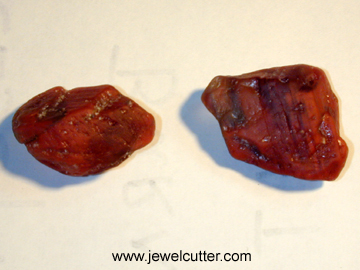
|
|
Recently I bought red labradorite rough from Bangkok. The material was sold to me as treated. Some of the treatment process
was disclosed to me. There are at least two types of treatments being performed. One treatment uses labradorite that already has copper in it. They are
probably using what is called schiller. Schiller labradorite has small particles of copper in the stone. The copper is what is giving this treatment its
color. The material is heated to diffuse the copper particles into the rest of the stone. Some of the treated stones using this process end up almost
opaque. I suspect that is what we are seeing in the two pieces of rough above. I have heated schiller in my oven and I have witnessed the copper particles
dispersing into the rest of the stone as color. The picture below is what I bought as treated from Bangkok. I have placed a piece of natural Oregon red
labradorite in with all the other treated material.
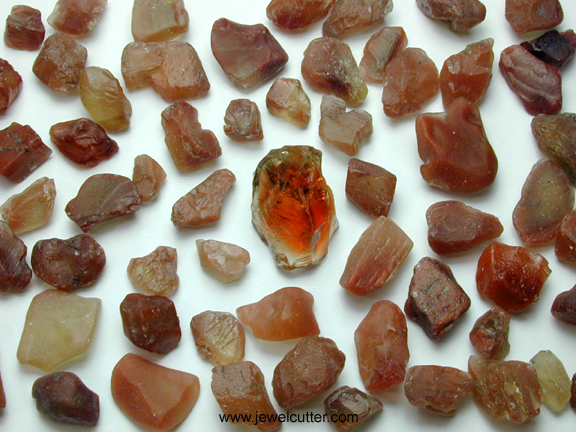
|
|
As you can clearly see the natural Oregon material looks nothing like the treated rough. Below is a close up of the same
natural Oregon labradorite. Notice that you can see some cleavage planes along with conchoidal fractures and sharp edges. You will not see this kind of
detail in any of the treated material I have seen. On the treated material all of the fine detail like the edges of the cleavage planes are filled in
with what I presume is flux. This is a dead giveaway. This is why there has been no rough for sale anywhere until recently. The release of this treated
rough makes it obvious as to why it was not being shown to anybody in the past years.
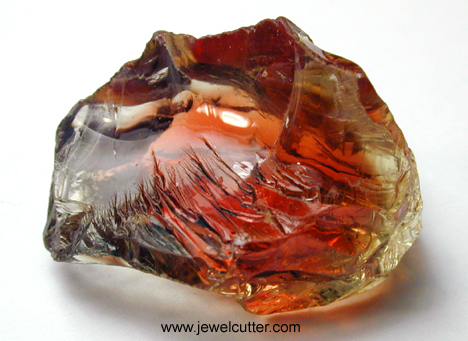
|
|
In the first picture below are six pieces of treated rough. Notice the dull surface of the stones. The recesses on the
surface of the stones have a crusty white apprearance.I think this look is attributed to a coating of flux that was used during the heating process.
Next look at the photomicrograph on the right for a more detailed view of the surface of one of the same six stones. In this picture I broke off part
of the stone. The part I broke off is on the right half of the picture. Notice the difference in the two surfaces. You can clearly see the coating I am
discussing.
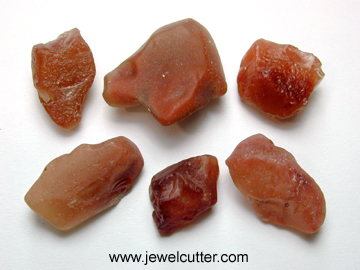
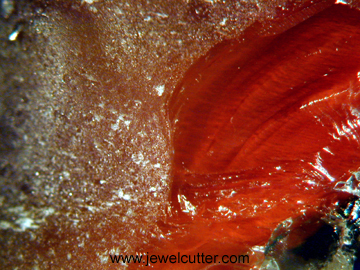
|
| The next treatment that we believe is being used involves the diffusion of copper and iron into labradorite. I have long suspected there was some sort of diffusion treatment similar to the beryllium sapphire treatment. I recently had personal communications with Mr. Masaki Furuya from the Japan Germany Gemological Laboratory (JGGL) who revealed some of the treatment the he has discovered. The process starts with the yellow labradorite. I think they must tumble the rough prior to treating to clean it up. Tumbling would remove any basalt matrix and all the thin sharp edges. The tumbled material is then placed in a crucible along with copper and iron particles. It is my supposition that the iron used is Feric Oxide (Fe2O3). I suspect there is also a flux involved but I don't know what kind at this time. Then the crucible is heated to approximately 1,400 degrees Celsius for one month. Then the material is removed and tumbled again. Tumbling at this point removes a layer of the copper, iron and probably flux. It is my understanding that after a month the color penetration stops due to the formation of this thick layer of copper, iron and flux. Perhaps the stone has absorbed all it can from the copper and iron that encases it at this point. Tumbling should expose a fresh layer that will take more diffusion of the copper and iron. This process is repeated for three months. |
|
The photos below are used with permission and the courtesy of Mr. Masaki Furuya from the
Japan Germany Gemological Laboratory and in cooperation with the
German Gemological Association (DGemG). It is my understanding JGGL and DGemG are working on an andesine publication.
When I have more information about the publication I will post it on this page. To my knowledge this is the first time photographic evidence of this
type of diffusion treatment has been published. Thank you JGGL and DGemG! These four pictures show the stages of the treatment starting with untreated
material through the three month process.
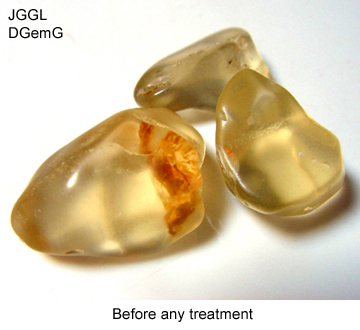
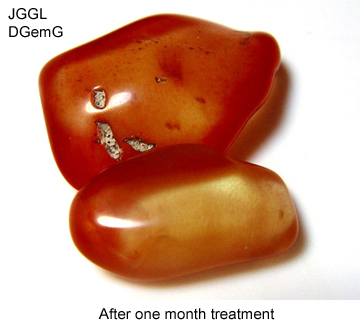
|
|
The three images below will take us full circle from treated rough, cut stone to flux inclusion. The third image below is
a photomicrograph I made of the same 1.01 carat andesine I bought off eBay. Of course it was represented as "all natural". The image is of a pit in the pavilion of the
stone. For scale purposes the depth of the pit is approximately 1mm. Compare the three images below. You will notice how nicely the crusty patch of
residual flux matches with the same crusty patches on the surface of the treated rough. The residual flux in the pit of the cut stone simply did not get
cut away during the faceting process. Are you convinced yet?
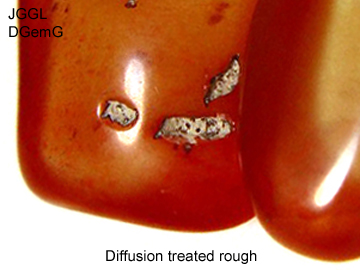
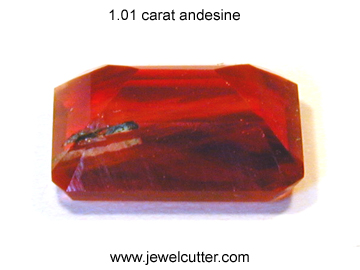
|
| At this point we have indisputable proof there is at least some treated labradorite that is being marketed as natural red andesine or red andesine-labradorite. I suspect the vast majority of red andesine is treated. Telling the treated rough from the natural rough is pretty easy. Now we need to work on separating treated and natural faceted or cabbed labradorite. I am working on my own collection of internal inclusion images that I will post here in the future. |
| One method of separating faceted or cabbed red andesine from natural Oregon labradorite seems to be the refractive index. The refractive index of Oregon labradorite is 1.57 to 1.58. The refractive index of andesine is 1.52 to 1.56. The RI is not proof that andesine is treated by diffusion but it does appear to be a valid method for separating andesine from Oregon labradorite. We have already seen positive photographic proof that some of the andesine rough is treated. Robert James of the International School of Gemology has also reported that andesine is biaxial negative. For more information on Robert James' work follow the links below. |
|
Robert James from International School of Gemology has done a lot of work on
developing tests to distinguish the natural material from treated. Below are links to his work.
Links to Robert James andesine articles.
|
|
There are a number of interesting blogs and articles about andesine. Listed below the ones I know about. If you have any
online articles you would like me to link to please feel free to contact me.
Links to andesine blogs and articles.
|
| If you are a former employee (or current) of JTV and have information you would like to share about the marketing of andesine I would like to hear from you. Feel free to contact me at the link at the top of this page. I am the only one who gets the email and I would like to hear your story. All contacts are confidential! |
| Updates coming as available. Thank you. |
|
|